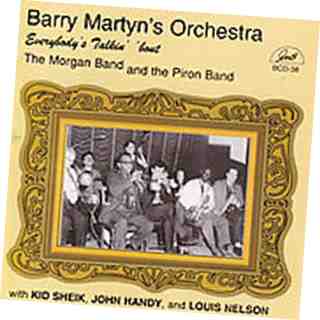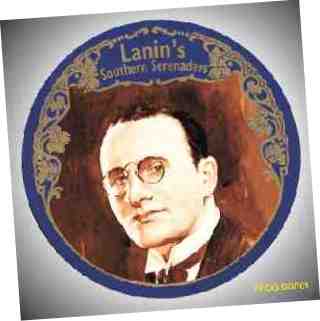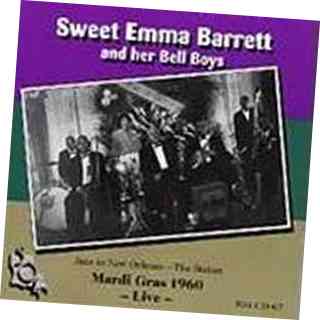
| Blow that thing! | ||||||||||
JBP's jazz reviews
Page 4.
Barry Martyn's Orchestra:
Everybody's Talkin' 'bout The Sam Morgan Band and the Piron Band.
GHB Records. BCD-38.
Barry Martyn playing the Morgan repertoire in 1966.
Tunes:
Bogalusa Strut;
Everybody Talkin' 'Bout Sammy;
Down by the Riverside;
Mobile Stomp;
Over in the Gloryland;
Short Dress Gal;
Steppin' on the Gas;
Sing On;
Bassic Blues.Musicians:
Kid Sheik Cola, Cuff Billett (trumpets);
Pete Dyer (trombone);'
Captain' John Handy (alto sax);
Frank Brooker (tenor sax);
Richard Simmons (piano);
Brian Turnock (bass);
Barry Martyn (drums).The Columbia recording of the Sam Morgan band in 1927 was a Jazz landmark. Although well-known and popular in New Orleans the Sam Morgan band was unlike other bands of the day. Instead of playing jazz standards and popular tunes, the Morgan repertoire taped in 1927 consists of traditional numbers like 'Down by the Riverside', and products of the Morgan band itself, both played with energy and zest.
The instrumental line-up, too, was not the usual trumpet, clarinet, trombone and rhythm section, but two trumpets, trombone, alto sax, tenor sax, piano and rhythm section. They ignored the often sniffy attitude to the saxophone and two saxes give the band a strong character of its own.
I always think of the Sam Morgan outfit as a circular band, hard-driving round the island at a road-junction, with bass, banjo and drums in the lead, vigorous and on one level throughout, without rising to a tearaway climax.
Barry Martyn was devoted to 1920s New Orleans jazz and his recreation of their repertoire, recorded in 1966, quickly establishes the Morgan atmosphere but remains circular only to the point of lift-off. The idea of alto player John Handy, the most fecund and fiery soloist of his day, playing along with someone else's notes at jazzing time would cause hair-loss in a barber's shop. The Martyn band breaks free and rocks on a rising tide.
The number called Bassic Blues (do they mean 'Basic Blues'?) is not from the Morgan menu, and I would guess that this boogie bash was suggested by Handy, who revels in it.
Barry Martyn had the luck to find Kid Sheik and John Handy from New Orleans touring England at recording time, and the band in consequence has enough lift and drive to raise the roof, reminiscences of the Morgan sound being used for breakaway. I would recommend this half of the CD to All - and Sundry, too, if he's at home.
The Piron orchestra, whose repertoire is the basis for the second half of the CD, is as unlike the Sam Morgan band as booze from beetles This was a highly sophisticated, easy-swinging outfit, led by a violinist, which played for dancing in posh New Orleans hotels, clubs and at festivities during the twenties. It was perfectly capable of serious jazz when the spirit took over, and numbers like 'Sud Bustin' Blues' are, quite simply, beautiful. The trumpeter Peter Bocage, clarinetist Lorenzo Tio and Steve Lewis on piano were jazz musicians of style and stature. They too had saxophones on board, so perhaps the Revivalist insistence on clarinet only was just daft.
The Barry Martyn band in 1960 makes no effort to come close to the Piron sound and character but plays items from its menu in more or less standard New Orleans style. Handy and Kid Sheik are missing and seriously missed. Old-timer Louis Nelsom, trombone, and Frank Brooker, tenor sax, get off the ground in Louisiana Swing, and Cuff Billett is always reliable.
Tunes:
Bright Star Blues;
Purple Rose of Cairo;
Bouncing Around;
Mama's Gone, Goodbye;
Louisiana Swing;
Sister Kate;
Kiss Me Sweet;
West Indies Blues.JBP
Shake It and Break It: Lanin's Southern Serenaders 1921-22.

Frog Records. FROG DGF61. 2006.
One of the 78s I bought in the early 1930s, aged 10, was 'You Can't Cheat a Cheater', played by Phil Napoleon's Emperors. Phil Napoleon plays a straight, confident lead trumpet, there's a lively guitar solo (Eddie Lang?), and solid work from clarinet and trombone. They all know what jazz is, and are enjoying it. Of course I encountered Napoleon often enough through the years, since no one recorded more, in such a variety of bands, always proving himself accomplished and reliable.
And here he is in Lanin's Southern Serenaders. What a disappointment! FROG have done valuable work by disinterring and reissuing forgotten groups of the 1920s and 30s, but Sam Lanin was a business man. not a jazz man, and these recordings are entirely commercial, with professional musicians politely pooling out popular tunes of the day in a manner guaranteed not to alarm, inspire; excite, or enliven respectable ladies spooning up their soup.
Only in a tune called 'Eddie Leonard's Blues' does the band awaken to find itself gently swinging, with Napoelon putting a touch of zip into his deft and determined lead, a highly accomplished guitar solo (Eddie Lang?), and a couple of other offerings proving that all members of the band are alive and well. For a few minutes, despite Sam Lanin, they believe they have a mission in jazz.
JBP
Sweet Emma Barrett and Her Bell Boys - Mardi Gras Day, 1960. Live in New Orleans.
(18 tracks). 504 Records.
Personnel:
Emma Barrett, piano;
Percy Humphrey, trumpet;
Jim Robinson, trombone;
Andrew Morgan, clarinet, tenor sax;
Creole George Guesnon, banjo;
Richard Alexis, string bass;
Cie Frazier, drums.
Gabriele Gad,the bright and bouncy keyboard player in Brian Carrick's band, sings a little ditty of her own composition which runs, 'Sweet Emma Barrett taught me how to play the blues.'
She did a good job, too. But we can't hear much of Emma on this recording. It's too rough, rowdy, rumbustious and full of shrieks,shouts,musical duels,dust-ups and dramas to the point where the only way to deal with the whole affair is by running commentary. Who wins the battle? It can't be Emma. The piano isn't loud enough.
Jim Robinson and Creole George, who's notorious for taking over any band he plays with, both play loudest and longest. Jim's trombone groans lustily and lugubriously throughout, and George won't let up for two-thirds of a minute. In New Orleans music trumpet's usually in charge, but with all this moaning, hooting, clipping, strumming, thrumming, drumming, rat-tatting, clanging and high speed bonging, trumpeter Percy Humphrey hardly gets a blow in and frustration makes him brassy. Andrew Morgan's clarinet has an eldritch shriek,but when he changes to tenor sax a warm sonority swims over the world. There's no time for contemplation or musical finesse, just tap-tap and go, an express train on the way to a party at the Zoo.
Let's see if we can join the party, starting with ALICE BLUE GOWN.
Emma's direct and honest piano is trying to show us jazz as conversation when Jim Robinson's laborious trombone rolls up to drown the neighbourhood. Wait! is that Percy getting in a brassy shout between the groans? And Andrew Morgan's night-bird clarinet goes chasing bats round the belfry.
Someone's singing? No, it's just spirited merriment among the assembled crowd, and a determined George has taken over.He's like a patent banjo-machine switched on at full power, inspiring druumer Frazier to start clacking, knocking,bashing and bonging as if he had three arms. A boisterous burst of rumpy-bump drives us past the winning post.
MACK THE KNIFE. You don't often hear this played by a hot jazz band but Jim's going like a ship's hooter and they're bumping it up with Percy playing straight.Now Andrew's singing. His voice isn't the greatest but he's got hold of the song and believes every word. He shouts to the band for support, and damn it, the whole thing has become really moving. What would Kurt Weill say? Wunderschon, I expect, with an umlaut here, an umlaut there, and everywhere an umlaut.
BILL BAILEY. Here's George, fast, loud and bumpy. Where's Jim? Here he comes, jumping like an overweight rabbit over tufts of grass. Emma has started to sing. We can hardly hear her for the row. The whole band is singing and clapping and now she's reached the piano and is playing with remarkably steady elan. Percy has started soaring into the empyrean. Ah, Bill Bailey has arrived.
SISTER KATE. This can't be Sister Kate, can it? I've never heard her played with this amount of solid bump. George is going strong and the drummer's banging and clacking with a holiday insouciance which makes everyone bawl lustily and never mind the tune.
ST.LOUIS BLUES. And this doesn't sound like St Louis Blues, either, or any blues whatsoever come to that. It's some sort of happy-clappy celebration with lots of bumps. George is strumming with furious zeal and something strange is happening. Andrew is blowing on tenor sax and holding a single note. He refuses to let it go. They're shouting him on. Is he going for the world record? He can't stop. Surely swomething will burst? Will it be Andrew? The effort seems supernatural, he'll need a doctor, but there's the note as strong as ever. Suddenly Jim can't stand it any more,his trombone groans aloud and Andrew sails away into silence.
Thank heaven he's still alive!.
JBP

Rare Cuts - Well Done - Vol ll 'Slip Horn'.
Kid Ory (tracks 1-9),
Preston Jackson (10-15),
The Missourians (16-20).
Jazz Crusade JCCD—3119.
In his programme notes for this CD Big Bill describes the Missourians as 'my favourite band of all time.' Well, if for any reason life begins to weigh heavily, I play the Missourians bursting with life on 'Market Street Stomp' or 'You'll Cry for Me'. They have bounce, drive, precision and let fly with a peculiar elan which I can only describe as 'ordinariness grown unique.'
They are without showiness and pretension and combine section playing and solos as if born to it. Their dynamo works. All I have been able to acquire of them to date is on a Neovox tape of the years 1925-30, compiled by Birmingham stalwart Norman Field.
Unfortunately, the group was swallowed in 1930 by Cab Calloway, who not only had showiness and pretension galore, but insisted on singing all the time, eventually pushing the Missourians out of instrumental fun into the dread big-band era.
Goodbye jazz.
Again unfortunately, the five tracks on this CD don't show them at their best. There's a strangely routine atmosphere as if they're waiting for lift-off and it doesn't come. The one track which gives you a feel of their true character is 'Snag 'Em Blues', which makes foot-tapping obligatory.
In any case, there's ample compensation on this offering of Big Bill's. We get nine tracks from one of Kid Ory's best outfits dated early nineteen-fifties, with Teddy Buckner going stratospheric on trumpet/and Ory himself growling away with extraordinary lyricism in a series of new-born solos.
The third contributor is a Preston Jackson group of 1926, one of the best years for jazz, and this is a strong, confident New Orleans-style unit. Jackson does some inspired groaning on trombone, trumpeter Shirley Clay tootles with characteristic staccato zest, and the unassuming Artie Starks plays with notable
grace both on clarinet and sax. Finally, Elzadie Robinson contributes authentically soulful singing on 'Houston Bound.'
This group is just what we need to restore sunshine in these dark winter days.
JBP
Go to Jazz Crusade Web-site (if you want to).
![]()